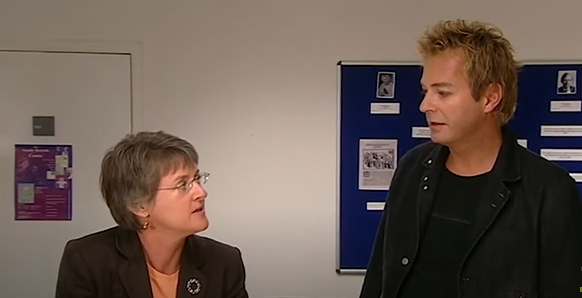In 2006, LGBT actor and comedian Julian Clary visited LSE Library as part of an appearance on the family history television programme “Who Do You Think You Are”. Here he met with LSE archivist Sue Donnelly to learn about his ancestors’ lives in London from Charles Booth’s Poverty Map.
To find out more about his great grandparents, German immigrant Herman and English Louisa Tiedemann, who lived in Victorian London, Julian Clary first met long lost relatives Joanne and Ivy. Ivy is Herman and Louisa’s daughter, Julian’s great aunt. Ivy relays to Julian that she was told that Herman wasn’t interned during the First World War because he was too ill. He died of tuberculosis when Ivy was three, in 1917.
This left his wife Louisa to bring up their seven children. She suffered from asthma and bronchitis and worked in a hotel washing up. Ivy believed Louisa’s family disowned her, but found it upsetting to talk to Julian about. She did provide him with Herman and Louisa’s wedding certificate, dated 2 April 1893, in which Herman is listed a baker. Julian surmised that as anti German sentiment in Britain was not at war levels in the 1890s, so he set out to explore whether it is possible that Louisa’s family actually disapproved of his living conditions and life in poverty.

At LSE Library, Sue Donnelly shows Julian the 1881 Charles Booth’s poverty map to help him understand what life was like in London at the time Herman and Louisa were married. Sue talks Julian through Charles Booth’s Poverty Map.

“Booth gathered information from across London and assigned each street a colour according to what he called its social condition. So it went from yellow which was wealthy and upper class and it went down to black which he defined in a very Victorian way as being vicious and semi criminal.” Julian’s relatives lived at Cornwall Cottages on Popham St in Islington, an area coloured on the map as black, light blue and dark blue.

“It’s not looking good is it,” commented Julian. Sue confirms it means that the majority of people on that street were earning less than 21 shillings a week, which was the minimum that a family of five needed to live on. “So no one on that street was making the minimum wage.”

“Within a few days I’ve got quite a clear and quite a grim picture of my grandparents,” summarises Julian. “I didn’t even know what either of them looked like and when I first looked at that picture of Herman and looked into his eyes and wondered what he was looking so sheepish about really. And also Louisa… she looked so grim faced, but she had to be. It may be that Louisa’s parents thought, ‘you made your decision and now you get on with it’. At that time they made some connection between poverty and immorality and that’s why the door was shut in her face. But it’s hard to come to terms with that they couldn’t have helped her a bit. You want to weep for them really.”
More about Charles Booth’s Poverty Map
Clips from this episode are available to watch on YouTube, with an overview on the Who Do You Think You Are webpages. Images used here are stills from the video “Julian Clary Uncovers Ancestors’ Post War Poverty”.





